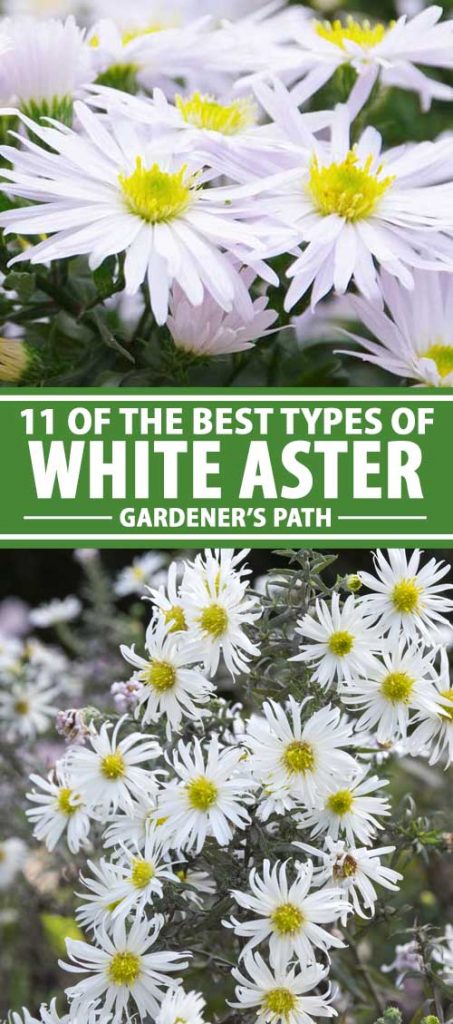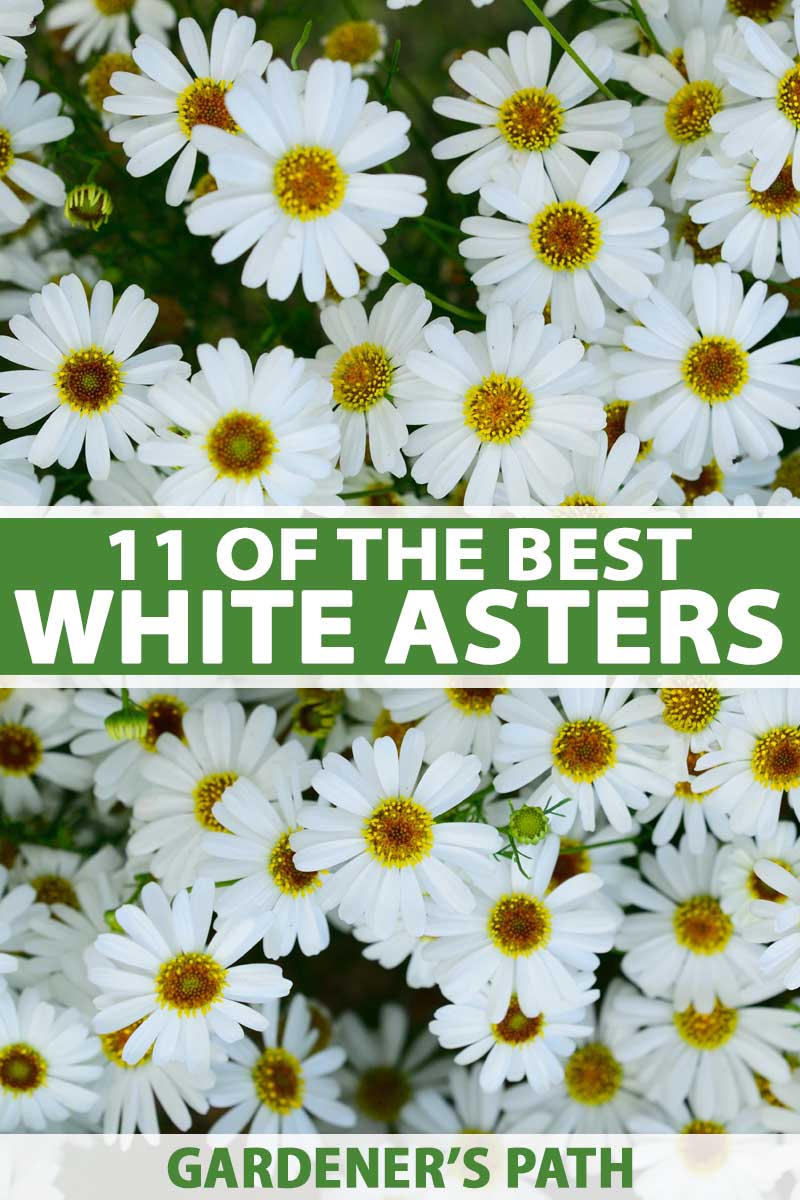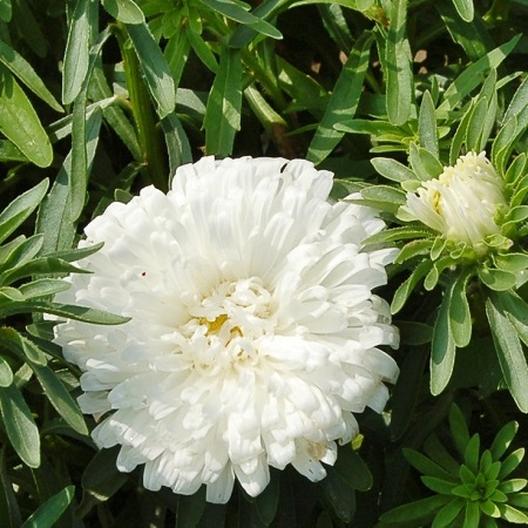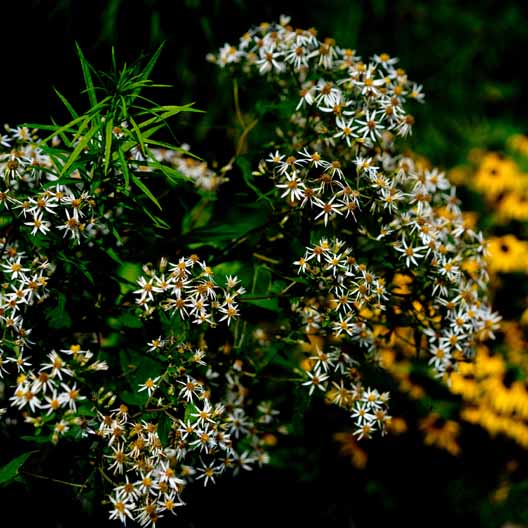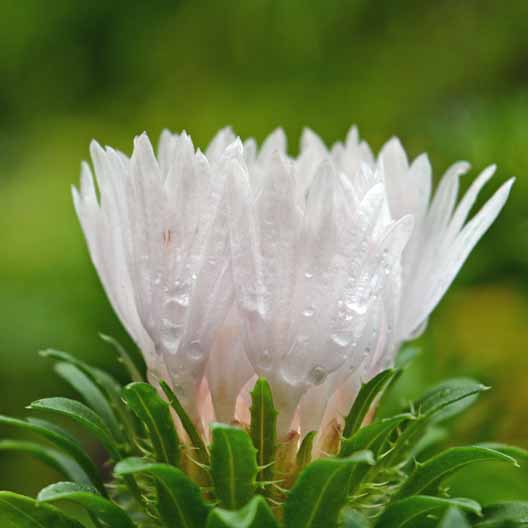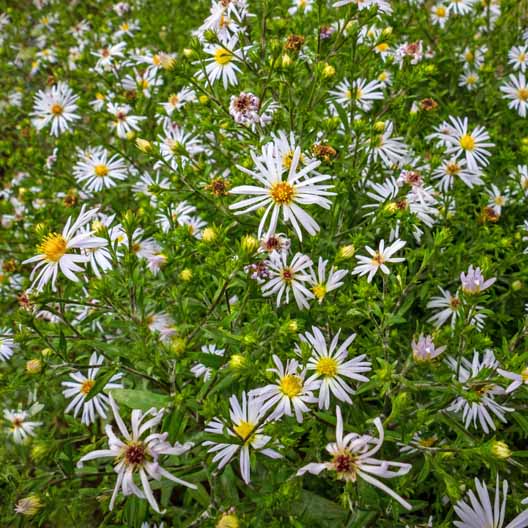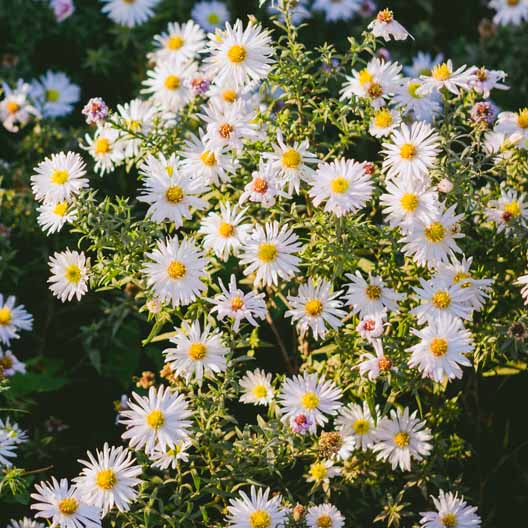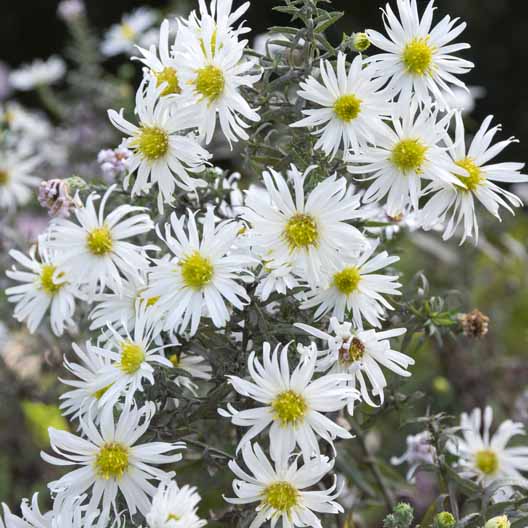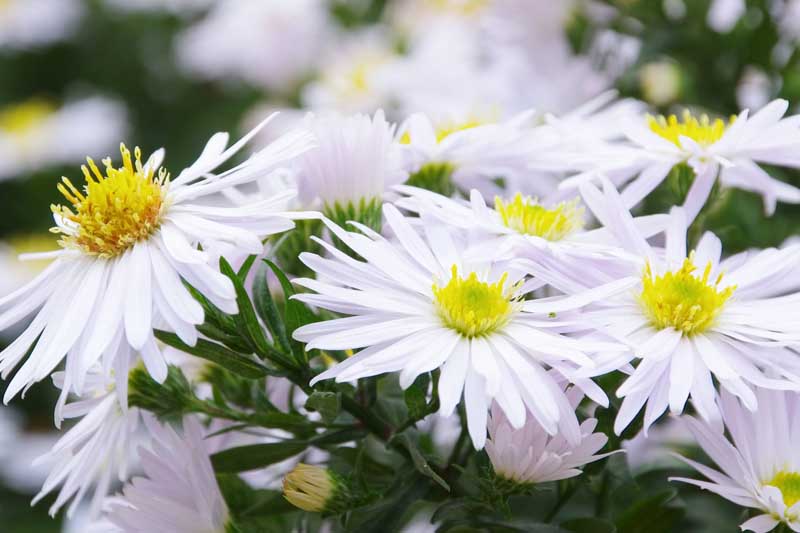You may be familiar with the blue, pink, and purple shades commonly found in late summer to fall gardens. But, did you know that asters are also available in white? We link to vendors to help you find relevant products. If you buy from one of our links, we may earn a commission. Here’s the lineup:
An Entr’acte of White
With 11 types to choose from, you’re ready to put asters on your gardening to-do list. Perennial species are vigorous growers that spread via extensive root systems and self-sowing, so investing in seeds is an economical way to line a woodland walkway or fill a meadow. Boltonia asteroides ‘Snowbank’ Unlike the true species that tops out at a leggy 5 to 6 feet, the ‘Snowbank’ cultivar grows to a more compact stature of 3 to 4 feet tall at maturity. Mounding, airy panicles are laden with 3/4-inch daisy-like flowers consisting of yellow centers and white rays that are sometimes tinged with pink. Mass plant in drifts, or use as dense hedging. Bloom time is late summer to fall.
2. Colour Carpet White
The china aster, Callistephus chinensis, is a non-native annual suitable for Zones 2 to 11. It prefers a full sun to part shade location and moist, fertile, well-draining soil.
‘Colour Carpet White’ There are numerous cultivars of this species available. ‘Dwarf Colour Carpet White’ is noted for its petite, 8- to 10-inch height. Its flower heads are 3 inches across and resemble those of a chrysanthemum. This type is an excellent choice for beds, borders, containers, rock gardens, and window boxes – where you want a temporary attraction that doesn’t return the following year. Bloom time is from late summer to fall. You can find seeds for this variety now at Eden Brothers.
3. Flat-Topped
The flat-topped white type, Doellingeria umbellata, aka ‘Parasol Whitetop,’ or tall white aster, is a US native perennial suited to Zones 3 to 8. It thrives in a full sun to part shade location and moist, well-draining soil. ‘Parasol Whitetop’ Aster This plant has a bushy, mounding habit and matures to a height ranging from 2 to 5 feet tall. Sparse-rayed flowers are 1/2-inch wide with yellow centers, and are arranged in a flattened, loose cluster. This type is ideal for areas with moist, sandy soil, where there’s room to roam. Bloom time is midsummer to fall.
4. White Wood
The white wood type, Eurybia divaricata, is a US native perennial suitable for gardeners in Zones 3 to 8. It grows best in a part to full shade location with soil of average quality, dry to moist conditions, and good drainage.
This type has a low profile, growing to a mature height of only 1 to 2 1/2 feet. Flowers have star-like rays with yellow centers that redden with age. They are about 1 inch in diameter, and cluster together for a flattened blanket of blossoms. This plant spreads with a mounding habit, and works well beneath airy tall trees and shrubs that afford ample air circulation. It’s tolerant of drought and dry soil. Bloom time is from late summer to fall.
5. Alba Stokes’
Stokes’ aster, Stokesia laevis ‘Alba’ is a US native perennial that thrives in Zones 5 to 9. It prefers full sun, and tolerates a variety of soil types. Good drainage is essential, and in colder regions, winter mulching is recommended.
Erect plants have stems with 2 1/2-inch individual flowers that feature profoundly divided rays. They resemble those of the bachelor’s button, Centaurea cyanus. Mature heights range from 1 to 1 1/2 feet tall, making this variety an ideal choice for small-space gardening. Blooming begins in spring, and continues through summer – with diligent deadheading to prevent plants from going to seed. In warm regions the leaves are evergreen. This is a drought- and rabbit-resistant plant.
6. Snow Flurry White Heath
The ‘Snow Flurry’ cultivar of the white heath species, Symphyotrichum ericoides, is a US native perennial ground-covering plant suitable for Zones 3 to 9. Heights range from 4 to 6 inches at maturity. This variety thrives in a full sun location with well-draining soil, and has low water needs, making it suitable for xeriscaping. Heath Aster (Aster pilosus) Tiny 1/2-inch flowers have slender rays with yellow centers that envelop the dense, creeping foliage. Look no further for a rock garden star with a bloom time from late summer well into fall. This type resists mildew, and tolerates drought and poor-quality soil. Another cultivar to look for is ‘Bridal Veil,’ which grows up to 2 feet tall at maturity, and exhibits greater density and an attractive arching growth habit.
7. White Panicled
The white panicled type, Symphyotrichum lanceolatum, is a US native perennial suitable for Zones 3 to 9, and thrives in full to part sun and moist, well-draining soil.
Clusters of mini-blossoms consist of daisy-like rays with prominent yellow disks that redden with age. Each measures 1/2 to 3/4 inches across. Heights vary widely from 1 to 5 feet tall at maturity. This variety is remarkable for how it clings to its brown and withered leaves as they curl with age. After other species drop their foliage, panicled types continue to add texture and interest to the garden. This is a vigorous grower whose erect stems have a tendency to flop sideways and may require staking. It blooms from late summer well into fall. Plant in a location where it can spread unchecked for a mass of color that creates privacy and a habitat for local wildlife.
8. Lady in Black Calico
The calico variety, Symphyotrichum lateriflorum, aka side-flowering or white-woodland aster, is a perennial US native that does well in USDA Hardiness Zones 3 to 8. It prefers a full sun to part shade location and dry to moist, well-draining soil. This one tolerates some over-saturation. ‘Lady in Black’ Calico Aster Symphyotrichum lateriflorum ‘Lady in Black’ calico aster is an especially attractive mounding cultivar that tops out at 3 to 4 feet tall. Clusters of 1/2-inch blossoms consist of sparse rays with striking red or purple centers, and grow along only one side of each stem. This drought-tolerant choice blooms from early summer to mid-fall. It readily naturalizes in moist, wooded settings. The foliage matures to deep purple. Bloom time is late summer into fall.
9. White Swan New York
The ‘White Swan’ cultivar of the New York aster, Symphyotrichum novi-belgii, aka Michaelmas daisy, is a US perennial that prefers full sun, and average to moist, well-draining soil of any type. It does best in Zones 4 to 8.
Daisy-like rays with bold yellow centers measure 1 1/2 inches across. Flowers grow in dense profusion over clumps of foliage that top out at 1 to 3 feet tall. Bloom time is from late summer into fall. Take care to provide adequate air circulation between plants to avoid powdery mildew. Similar cultivars are ‘Boningale White’ and ‘White Ladies.’
10. Frost
The frost variety, Symphyotrichum pilosum, aka hairy aster, is a US native perennial suitable for gardens in Zones 4 to 8. It requires full sun to part shade and soil that is moist and well-draining. Some over-saturation is tolerated.
This plant has a bushy growth habit and a mature height of 4 to 5 feet. Its stems and leaves are hairy. Slender-rayed blossoms measure 3/4-inch wide and sport prominent yellow center disks. This wildflower naturalizes readily, to the point that it is sometimes considered a weed. However, massed in a meadow, it creates a bright, cheerful vista. Bloom time is from late summer into fall.
11. Arrow-Leaved
The arrow-leaved variety, Symphyotrichum sagittifolium, is a native perennial that thrives in Zones 3 to 9. It prefers a full sun to part shade location, and dry to average soil that drains well. Tall stems of 1 to 4 feet bear dense, cone-shaped clusters of tiny, multi-rayed blossoms that measure 1/2-inch across. The rays are generally white, but may be light blue. The centers are light yellow and redden with age. This type is easily distinguished from others by its heart-shaped basal leaves. Grow it in woodland settings where it has room to spread freely. Bloom time is from late summer into fall. Note: There is also a species called Arrowleaf, Symphyotrichum urophyllum. It has the same stature and bloom time. The two are often referred to interchangeably.
And native varieties are especially energetic, so plan to give them lots of room to roam. Prepare to be amazed by the wonderful assortment of beneficial insects and backyard birds these plants attract. Masses of snowy-white asters act as a “palette” -cleansing interlude between summer’s waning hues and the vibrant autumn colors to come. If you’re like me, you’re going to appreciate the serene ambiance of a garden full of white blossoms that brighten the yard by day and seem to shimmer in the moonlight. If you found this article informative, you may enjoy reading some of our other aster guides next:
Grow New England Aster for Sensational Summer and Fall Color When and How to Divide Perennial Asters When and How to Save Native Perennial Aster Seeds 21 Tips for Managing Perennial Asters in the Garden
© Ask the Experts, LLC. ALL RIGHTS RESERVED. See our TOS for more details. Product photos via Eden Brothers, Everwilde Farms, Hazzard’s Seeds, and Roundstore Native Seeds. Uncredited photos: Shutterstock.
